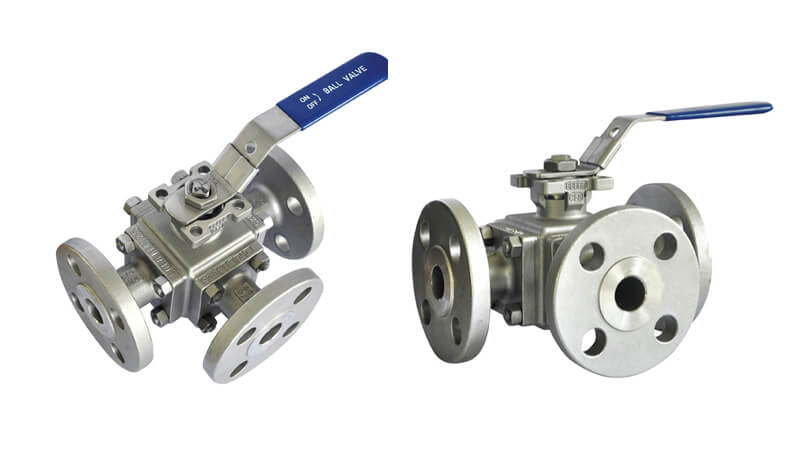The working principle of the three-way ball valve is to open or close the valve by rotating the valve stem. The ball valve switch is lightweight, small in size, can be made into a large caliber, reliable sealing, simple structure, easy maintenance, the sealing surface and spherical surface are usually closed so it is not easy to be eroded by the medium, and the three-way ball valve is widely used in various industries.

The three-way ball valve is mainly used to cut off, distribute and change the flow direction of the medium in the pipeline. Three-way ball valve is a relatively new type of ball valve, which has some unique advantages of its own structure, such as a non-friction switch, seal parts are not easy to abrade, and opening and closing torque are small. Those reduce the size of the actuators.
Three-way ball valves are available in T and L types. T type can make three orthogonal pipelines communicate with each other and cut off the third channel, which plays the role of diverting and combining. The L three-way ball valve type can only connect two pipes that are orthogonal to each other, and cannot maintain the mutual connection of the third pipe at the same time, it is only for distribution.
Feature of Three-way Ball Valves
The three-way ball valve adopts an integrated structure. The sealing type of the four-sided valve seat has fewer flange connections, high reliability, and lightweight design.
Three-way ball valve has a long service life, large flow capacity and low resistance.
Three-way ball valve is divided into two types according to its functions: single-acting and double-acting. The single-acting type is characterized in that once the power source fails, the ball valve will be in the state required by the control system.
Ball valve and gate valve belongs to the same type of valve. The difference of them is that the closing part is a ball. The ball rotates around the centerline of the valve body to open and close the valve. The ball valve is mainly used to cut off, distribute and change the flow direction of the medium in the pipeline. The ball valve is a new type of valve widely used, which has the following advantages:
- The fluid resistance is small, and the resistance is equal to the pipe length.
- Simple structure, small size and lightweight.
- It is tight and reliable. The sealing surface material of the ball valve is widely used in plastic and has the good sealing performance. It has also been widely used in vacuum systems.
- Easy operation, fast opening and closing, only need to rotate 90 ° from fully open to fully closed, which is convenient for long-distance control.
- Easy maintenance, the simple structure of ball valve, the seal ring is usually movable, and it is more convenient to disassemble and replace.
- When fully open or fully closed, the sealing surface of the ball and valve seat is isolated from the medium, and the medium will not cause erosion of the valve sealing surface when the medium passes.
- Wide range of application, from small diameter to several millimetres, large to several meters, from high vacuum to high pressure can be applied.
The high platform ball valve can be divided into straight type, three type and right angle type according to its channel position. The latter two types of ball valves are used to distribute media and change the flow of media.
Operation Principle
Open process
- In the closed position, the ball is pressed tightly on the valve seat by the mechanical pressure of the valve stem.
- When the hand-wheel is turned counterclockwise, the valve stem moves in the opposite direction, and the angular plane at the bottom makes the ball release the valve seat.
- The valve stem continues to lift so that the ball starts to rotate without friction.
- Until the fully open position, the valve stem is lifted to the extreme position, and the ball is rotated to the fully open position.
Close process
- When closing, rotate the hand-wheel clockwise, the valve stem starts to descend and the ball leaves the valve seat and starts to rotate.
- Continue to rotate the hand-wheel, and the valve stem is affected by the guide pin embedded in the spiral groove on it, so that the valve stem and the ball are rotated by 90 ° at the same time.
- When it is about to be closed, the ball has been rotated 90 ° without contacting the valve seat.
- The last few turns of the hand-wheel make the ball tightly pressed against the valve seat to achieve complete sealing.
Attentions of Installation and Maintenance
- Keep the position for the valve handle rotating.
- It cannot be used for throttling.
- Ball valves with transmission mechanism should be installed upright.
